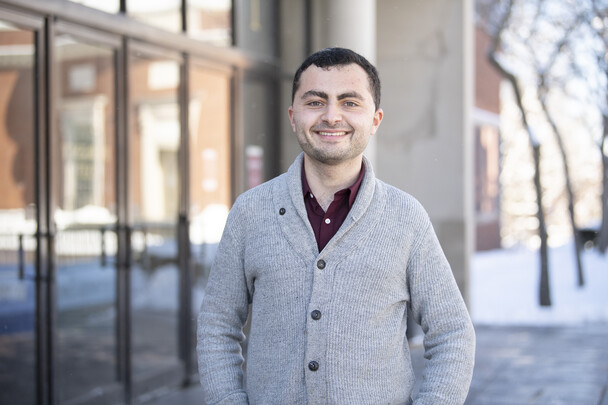The Sounds That Inspire Science
GSAS students talk about the music they love and its influence on the research they do

Research at Risk: Since World War II, universities have worked with the federal government to create an innovation ecosystem that has yielded life-changing progress. Now much of that work may be halted as funding is withdrawn. Find out more about the threats to medical, engineering, and scientific research, as well as how Harvard is fighting to preserve this work—and the University's core values.
“Music has no effect on research work,” said Albert Einstein, who loved his violin, “but both are born of the same source and complement each other through the satisfaction they bestow.” Not so fast, say three GSAS students. Like Einstein, the PhD candidates get great satisfaction from their favorite pieces of music, but they also see reflected in those works the same characteristics that draw them to fields like chemistry, biophysics, and astrophysics. Whether hip-hop, classical, or jazz, the music the students love does in fact shape and inspire the science they do. And, in at least one case, science inspired the creation of a piece of music.
Snap Together
A passion for music may be in Jason Anesini’s DNA. His father Vic Anesini, an engineer for Sony’s recording division, has been nominated for two Grammy Awards for his work remastering classic recordings by Elvis Presley and Johnny Cash. As a teenager, the younger Anesini loved to sing and was part of a choir that performed at New York’s Carnegie Hall. While he tried making his own music, however, he found as he got older that “science came more naturally.” Today, as a doctoral student in the Department of Chemistry and Chemical Biology, Anesini constructs “complex chemical scaffolds that are designed as a targeted form of chemotherapy.” He cites rapper Westside Gunn’s breakthrough album, Pray for Paris as a prime example of the way that hip-hop, like chemistry, takes different components and connects them in creative ways to make something new.

My field—synthetic organic chemistry—is really based on building things, so I feel in a sense like I did when I was a kid trying to make music with Garage Band or something. I feel like it’s a [hip-hop producer] J Dilla 1990s track and I'm just doing kick and snare [drums] and building up from there. Nature gives you this beautiful natural product, this starter unit that's going to be wrapped around an enzyme, and you just kind of snap it together like you would put together a set of Legos.
With Pray for Paris, you have the jazzy brass stuff, but it's being used to make the beat swing. I just love the way those things snap together. The album also has a political aspect. You hear that title and you think, “Okay, this is going to be about the terrorist attacks in Paris.” It's actually a take on the opulence of classic European culture, opening with a recording of the $400 million auction of Leonardo da Vinci’s painting “Salvator Mundi.” So, it brings in all these different concepts and influences.
I’ve always used music to connect different points in my life as well as in the science I do.
I’ve always used music to connect different points in my life as well as in the science I do. Pray for Paris brings me back to my sophomore year of college when I started getting into 90s hip-hop like Digable Planets and A Tribe Called Quest. Westside Gunn is from Buffalo, which is really close to Binghamton where I went to school. When I listen to it, I'm back in upstate New York. It's cold. It's wet and overcast with lots of clouds. I’m sitting on the porch watching the rain with a Natty Light beer or something. It’s my senior year again. And just like that, I’m right back there.
A Whole Greater Than Its Parts
As a fourth-year student in the biophysics program of Harvard’s Graduate School of Arts and Sciences, Amir Bitran appears to have taken after his scientist mother, Iris Berent, who studies cognitive linguistics as a professor at Boston’s Northeastern University. Like his father, Saul Bitran, and two uncles who make up three-quarters of the internationally acclaimed Cuarteto Latinoamericano string quartet, however, Bitran loves music. He brought his two passions together in When DNA Makes Loops, a piece that premiered in Paris in 2019 as part of the Muse-IC project, an initiative of the Institut Curie that commissioned composers like Bitran to write music inspired by cutting edge science. He is inspired by Bach’s Mass in B Minor, the symmetry and complexity of which Bitran says he also finds in science.

Music and science used to be just complimentary for me. I didn't like the idea of mixing them because I always thought that science was a very logical pursuit, but the best music happens when “b” doesn't always follow “a,” when you violate the rules a little bit. Recently, though, I’ve started to realize some of the similarities. Sometimes in science, you need “out of the box” thinking in order to figure out what's the best way to approach a centuries-old problem or even a new problem like the coronavirus. At the same time, I find inspiration in beautiful topics within the scientific and natural world, which are discovered through logical thinking and rigorous experimentation.
It was in my teenage years that I started to see both music and science as a part of me. When I was an undergraduate in 2012 and 2013, I was part of the Harvard University Choir at the Memorial Church and we sang Bach’s Mass in B Minor. I just fell in love with it. It's not like nowadays, when you have your melody and you have your harmony. In the B minor mass, every voice is doing its own thing. Every voice has a melody. Each is beautiful all by itself. But when you put all the melodies together, you get this beautiful large-scale structure that you couldn't have anticipated just by listening to one of the lines alone.
In the B minor mass, every voice is doing its own thing. Every voice has a melody. Each is beautiful all by itself.
I find that dynamic also in the science I do. In the case of biophysics, individual proteins structure entire organisms and atoms structure the proteins. Each atom within the amino acids—a protein’s Lego building blocks—obeys its own rules according to the laws of physics. Thanks to these physical principles, the amino acids rearrange themselves into a protein structure, and that structure is what lets the protein do its thing—just like a car needs a structure in order to function. They evolve and interact with each other and with their environments. And when a baby is conceived and it's developed in the womb, each cell does its own thing, but because of the physical principles involving communication between them, the baby takes shape. It’s a collective behavior where different pieces—in this case, each cell—has its own rules. It doesn’t necessarily “care” about the big picture, but because of the physical interactions, you end up with something beautiful.
Tension and Release
Jesse Han grew up in South Korea listening with his parents to Eric Clapton, Simon and Garfunkel, and John Denver. He took naturally to the traditional musical instruments to which he had access in high school and enjoyed arranging “American songs with a Korean vibe.” Han fell in love with jazz and dance when he went to college at the University of Virginia, so much so that he started to take part in Lindy Hop competitions up and down the East Coast. A PhD student in astrophysics who studies “galactic fossils” to reconstruct the history of the Milky Way, Han says that Lionel Hampton’s jazz standard “Flying Home” exemplifies the three qualities that also inspire his love of science and of his third passion, rock climbing.

I remember the moment that “Flying Home” clicked for me. There was a dance competition, the Collegiate Lindy Hop Championships, that took place some years ago in Washington, DC I made it to the finals. It was tense. I was very stressed. They put on some music before the competition—"Flying Home.” I knew I was right where I wanted to be. I was ready to pour out my soul on the dance floor.
Today at Harvard, there are three things I spend my life on: astrophysics, mountaineering, and music and dance. Each of them has three essential qualities: improvisation, tension and release, and completion.
In my astrophysics research, there’s a lot of data, so I write computer code to analyze it. I certainly write in a very improvisational way. There’s a lot of tension and release in the process. There are times when it looks like it’s not going to work out and then suddenly, it does. Most important, there’s a sense of completion. The projects I do are their own little chunks of science. And, of course, in mountain climbing, you’re constantly improvising in the environment. There's always tension and occasional release. And then when you’re at the summit, it is a closure, a completion.
Today at Harvard, there are three things I spend my life on: astrophysics, mountaineering, and music and dance.
From the point of view of jazz, tension and release is what makes it music. With “Flying Home,” it’s upbeat, it’s consistent, and then there’s a massive break at the end. People just lose their minds. During the song, dancers create a jam circle and a pair or a solo dancer enter, take a couple of bars of the song, and dance as hard as they can. That’s the improvisation. But the song is complete. It’s not just a jam session where you’re going on and on. There’s closure to it. All these characteristics combine for this intense collaboration and community between musicians and dancers. Whenever the tune comes on, everyone knows what to do. It really is its own little world.
Photos by Tony Rinaldo
Get the Latest Updates
Join Our Newsletter
Subscribe to Colloquy Podcast
Simplecast



